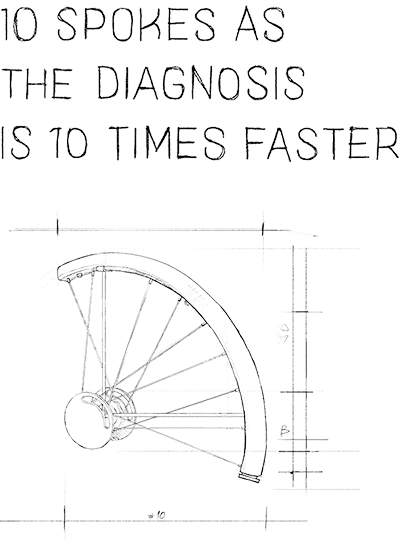Multiple sclerosis (MS) is a chronic disease of the central nervous system that affects 3,600 people every year in our country, manifesting itself more frequently between the ages of 20 and 40.[1] When one of these young people receives the diagnosis, the first thought is "wheelchair".
Truth is that, thanks to the advances in research, at least 75% of people with MS will not need a wheelchair.[2][3]
To welcome this new future, the designer Derek Castiglioni joined forces with a group of young people with MS, and together they deconstructed a wheelchair, transforming it into a design chair.
A normal, everyday chair, inspired by the stories of these young people and by achievements of medicine.
Willchair today is not just a neologism, but it is mostly a symbol that allows the newly diagnosed patients to leave their worst fears behind, and look to the future with new confidence and determination.
Being aware of the fact that, thanks to early diagnosis and adherence to therapies, all together we can slow down the progression and change the course of MS.[4][5]
Design
The design of Willchair comes from the combination of the experience of people with MS and the enormous progresses made by scientific research.
Tremendous progress has been made in the treatment of MS, as a result of a better understanding of the disease. The development of highly effective therapies has made it possible to achieve an almost complete control of relapses and inflammation.[5]
A key factor is the collaboration between doctor and patient.[6] Considering the treatment options currently available, the neurologist can choose the therapy according to the needs of each person with MS.[7]
To maximize the effectiveness of the available therapies, it is important to start the treatment in a timely manner (if there is an indication) and to follow it consistently. In fact, early treatment allows to significantly improve the long-term course of the disease, delaying the progression.[4]


Another key factor to achieve good results lies in what in medical jargon is called "adherence", intended as "the patient's compliance with the doctor's recommendations regarding timing, doses and frequency of taking the drug for the entire cycle of therapy”.[8]
Good adherence is associated with a lower risk of relapses and disease progression.[6]
Talking about it with a doctor is essential to identify the most suitable plan and receive support in managing the care.
“Transforming a wheelchair into a design chair helps to see a different future, a better future, a colorful future”
(Pinda)

Willchair is a co-creation project between designer Derek Castiglioni and a group of young people with multiple sclerosis: Arianna, Daniela, Leonardo and Pinda.
In the videos below the protagonists, who literally inspired the design of the chair with their stories, tell their own "will" sharing hope, desire for the future and a lot of willpower. Dedicated to all the people who receive a new diagnosis of multiple sclerosis every day.
Multiple sclerosis is described as a success story in neurology, made possible by the advances in the understanding of disease, that led to earlier diagnoses, and by discovery of effective new treatments.[9]
Treatments which, if taken promptly and continuously, can radically improve the course of the disease.[6][9]
Dr. Luigi Lavorgna, a neurologist at the Neurology Division of the University of Campania "Luigi Vanvitelli" in Naples, tell us more about that in this video.
Bibliografia
-
AISM. Barometro della sclerosi multipla e patologie correlate 2022. disponibile al link: https://www.aism.it/sites/default/files/Barometro_2022_estratto_web_1.pdf
-
Myhr KM et al. Disability and prognosis in multiple sclerosis: demographic and clinical variables important for the ability to walk and awarding of disability pension. Multiple Sclerosis (2001) 7, 59-65
-
Ozakbas S et al. The 20-Year History: Change of Multiple Sclerosis Patient Profile over 20 Years, Multiple Sclerosis and Related Disorders (2019), doi: https://doi.org/10.1016/ j.msard.2019.05.002
-
Giovannoni G et al. Brain health: time matters in multiple sclerosis. Multiple Sclerosis and Related Disorders (2016), 9:S5–S48.
-
Hauser S. L et al. Treatment of Multiple Sclerosis: A Review. The American Journal of Medicine 2020; 133(12):1380–1390.e2.
-
Kołtuniuk A et al. Adherence to Therapy in Patients with Multiple Sclerosis-Review. Int J Environ Res Public Health. 2022; 19(4): 2203.
-
Inojosa H et al. The need for a strategic therapeutic approach: multiple sclerosis in check. Ther Adv Chronic Dis. 2022; 13: 20406223211063032.
-
AIFA. Aderenza alle terapie e strategie per migliorare l’uso sicuro ed efficace dei farmaci. Disponibile al link: https://www.aifa.gov.it/-/aderenza-alle-terapie-e-strategie-per-migliorare-l-uso-sicuro-ed-efficace-dei-farmaci#:~:text=Per%20aderenza%20alla%20terapia%20si,l'intero%20ciclo%20di%20terapia.
-
Cerqueira J. J et al. Time matters in multiple sclerosis: can early treatment and long-term follow-up ensure everyone benefits from the latest advances in multiple sclerosis? J Neurol Neurosurg Psychiatry 2018;89:844–850.
